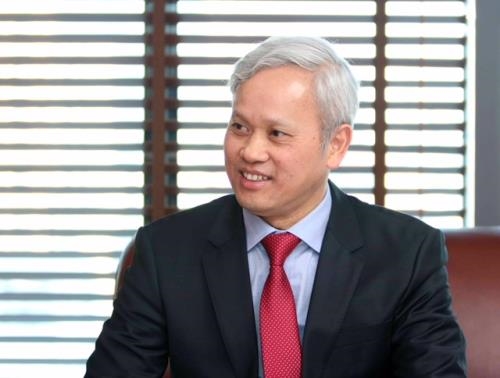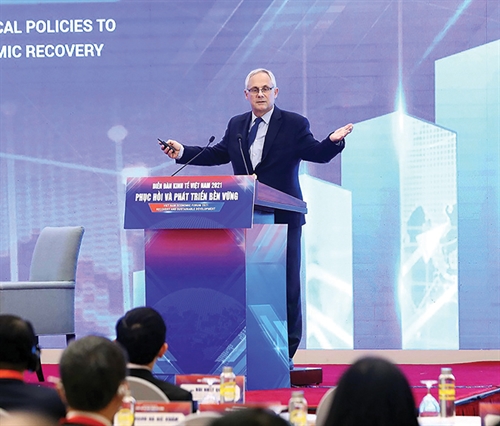Pham Ha Thanh[1], Doan Minh Duc[2], Nguyen Hoang Hiep[3]
The 2008 financial crisis brought about significant implications on the financial services sector. The first was the awareness that major finance institutions’ practices could pose serious systematic risks, leading to tightened regulations, including reserve and solvency requirements to mitigate future risks, which were associated with higher compliance costs, placing double burden on financial institutions by requiring them to set aside reserves and limiting their activities[4]. Second was that compliance and operational costs combined with bank restructuring triggered massive layoffs of professionals in the finance sector. With their expertise, laid-off professionals joined or launched startup companies, offering technology-enabled and customer-centered services to disintermediate traditional players. Third was the loss of trust in finance institutions managing to tackle the crisis not because of effective management strategies but governments’ bailouts to save the financial market from collapse. If banks could not control their own risks, how they could be entrusted with customers’ money. As a result, a new generation of customers started to trust Fintech companies who could offer innovative solutions to financial services.
What is Fintech?
Fintech is the combination of two factors: Finance and Technology. For the time being, there is no official or legal definition of Fintech. It should be noted that how Fintech is defined hinges upon the specific contexts and different approaches. However, the common denominator in most definitions is the application of technologies to enhance financial services. Financial Stability Board[5] defines Fintech as “technologically enabled financial innovation that could result in new business models, applications, processes or products with an associated material effect on financial markets and institutions and the provision of financial services”[6]. Based on Patrick Schueffel’s research, Fintech is a new financial industry that applies technology to improve financial activities[7]. For the purpose of the article, Fintech could be defined as “an industry made up of organizations using innovative financial technology to support or facilitate financial services”, and financial technology is all parts of technology that help provide financial services and products to customers.
 |
| VNPAY has become a popular payment solution__Photo: https://bankingplus.vn/ |
Development of Fintech in Vietnam
Under Vietnam Fintech Report 2020[8], the number of Fintech companies in the country rose by 197 percent from 2017 to 2020 with the total of 115. These mainly specialize in four areas: digital payment, peer-to-peer (P2P) lending, cryptocurrency, and asset management. The digital payment and P2P lending dominate the market with 33 percent and 15.5 percent, respectively. Additionally, the business model adopted by most Fintech companies is business-to-customer (B2C). Investments into Vietnam’s Fintech market have also observed a substantial rise. In 2019, VNLIFE Corporation bagged an investment amount of USD 300 million from SoftBank and GIC[9]. In 2021, MoMo, an intermediate payment service provider, secured a funding worth USD 100 million in Series D from Goodwater, Warburg Pincus, Affirma Capital and Tybourne Capital Management[10]. Solidiance, in a report released in 2018, predicted that Vietnam’s Fintech sector would reach the value of USD 7.8 billion in 2020[11].
Vietnam’s regulatory responses to Fintech
The Vietnamese Government has been implementing multiple policies, programs and projects to cultivate a favorable environment and create an enabling infrastructure for the facilitation and diversification of Fintech products. Before 2020, it can be said that the Vietnamese Government followed the “wait-and-see” approach under which regulators mostly played the role of primary observer.[12] Fintech businesses in Vietnam were licensed on the grounds of existing regulatory frameworks with the explicit intention to allow innovations to develop unhindered by what could be interpreted as disproportionate regulatory requirements; those, that might disincentivize competition or be potentially disproportional to the risk posed or the economic usefulness of the product offered[13]. In theory, Vietnamese regulators are enabled to better understand Fintech products and their possible applications in the financial sector, culminating in the change in regulations over time. Some policies reflecting this approach include: Prime Minister Decision 2545/QD-TTg approving the Scheme on development of cashless payment in Vietnam during 2016-20 and Decision 1255/QD-TTg approving the Scheme on completion of the legal framework on management of virtual assets, digital currencies and virtual currencies.
However, the pre-2020 approach inhibited Vietnam’s emergence as a regional Fintech leader and failed to capitalize on market opportunities. Since 2020, the Vietnamese Government has switched to the “innovation facilitator” approach. This is manifested in Decision 283/QD-TTg approving the Scheme on restructuring of the service sector and Decision 999/QD-TTg of 2019 approving the Scheme on development of the sharing economy. Notably, Decision 999/QD-TTg authorized the State Bank of Vietnam (SBV) to draft a decree on Fintech regulatory sandbox, providing regulated and unregulated entities with an opportunity to test innovative products or services, business models, and delivery mechanisms relating to the provision of financial services.
The pilot mechanism in Vietnam was drafted with three main goals: (i) fostering innovation, creativity and modernization in the banking sector; (ii) creating a testing environment to enhance the existing regulatory framework; and (iii) ensuring the interests of customers participating in trial unlicensed Fintech services. The pilot mechanism will be applied to two subjects: credit institutions and Fintech companies. These institutions must operate in the following areas: digital payment, credit, P2P lending, customer identification support, open API, innovative technology application solutions, and other services supporting banking activities. In principle, Fintech solutions and services registered for the pilot mechanism must fall within the purview of these areas. However, for areas outside the scope of application, if there are potential and benefits to society, the Prime Minister will decide to green-light their participation in the program. The pilot program consists of four main phases: application acceptance phase, preparation phase, testing phase, and evaluation phase.
Vietnam’s legal framework on Fintech
Regulatory development for Fintech’s underlying technologies
Enabling technologies mainly adopted in Fintech are: application programming interfaces, cloud computing, artificial intelligence, biometrics and blockchain. There is no clear legal framework on any of those technologies. Therefore, general and overarching regulations on science, technologies, information technology, and intellectual property can be applied, including: the 2005 Law on Intellectual Property, the 2006 Law on Information Technology, the 2008 Law on High Technologies, the 2013 Law on Science and Technology, the 2015 Law on Cyber Information Security, and the 2018 Law on Cybersecurity. However, such regulations merely intend to facilitate the research, development and application of technological innovations while ensuring the protection of database and intellectual property related.
Regulations on Fintech services
Digital payment
Vietnam’s existing regulations on digital payment focus mainly on governing mobile money and e-wallet. The relevant regulations are the 2010 Law on Credit Institutions, Government Decree 101 of 2012 on cashless payment, and SBV Circular 39 of 2014 guiding intermediary payment services. The latest one is Prime Minister Decision 316 dated March 9, 2021, allowing the use of mobile money to pay for small-value goods and services. Accordingly, the provision of payment services by Fintech companies is licensed by the SBV and it includes electronic payment gateway[14] and e-wallet[15]. Conditions on intermediate payment services of Fintech companies include (i) establishment license/enterprise registration certificate; (ii) business plan; (iii) legal capital of at least VND 50 billion; (iv) qualifications and experiences of the legal representative and general director (director); (v) facilities, technical infrastructure, information technology systems, and appropriate technology solutions; and (vi) management accounting information system. In addition, the regulations on procedures and dossiers for grant, revocation and renewal of licenses for provision of intermediate payment services could be found in Government Decree 101 of 2012 and Decree 80 of 2016 and State Bank Circular 39 of 2014 and Circular 30 of 2016. These have created the legal basis for setting up Fintech companies to provide digital payment services.
E-wallet
E-wallet providers are required to identify and authenticate customers by requesting customers to file papers to open an e-wallet. An individual or organization is required to provide sufficient information and papers for verification of his/her/its identity. An e-wallet must be linked to a payment account opened at a commercial bank. Any acts of fund intermediation (e.g., credit provision) or charging interests via e-wallets are strictly prohibited. A customer could only open one e-wallet of one provider, withdraw or top up through a linked payment account, and receive funds from another e-wallet of the same provider. The monthly transaction cap for each e-wallet is VND 100 million, except for e-wallet being a point of sale (POS)[16].
Fund safeguarding measures are also put forth. Firstly, to address the liquidity risk, e-wallet providers are required to hold funds equaling 100 percent of the electronic money float in a separate account. In contrast, the insolvency risk remains ungoverned. It should be noted that such risk is not only possible to e-wallet providers but also to banks to which e-wallets are linked. While some countries have regulations to isolate and ring-fence customer funds from the e-wallet provider’s assets so that they cannot be seized by external creditors[17], there is no equivalent regulation in Vietnam. The same goes for the insolvency risks of the banks with which the funds are placed. Deposit insurance is not covered in this case since it could only be applied to deposits placed at commercial banks and other credit institutions allowing deposit taking. Furthermore, to ensure financial stability, an e-wallet must not be capitalized for money laundering and terrorism financing.
The practices of hiring, renting or borrowing an e-wallet and selling or purchasing e-wallet data are banned. Similarly, an e-wallet provider is obliged to set out anti-laundering and counter-terrorism measures in accordance with the relevant laws, also expected to report to and cooperate with the SBV and other relevant authorities in the event of suspicious and illicit transactions.
Mobile money[18]
On March 9, 2021, the Prime Minister issued Decision 316 to approve a two-year pilot program, allowing the use of mobile money to pay for small-value goods and services. Accordingly, users would open a mobile money account attached to their SIM number but separated from the telecoms account. A bank account is not required but the mobile account could only be used for payment of goods and services with the monthly maximum value of VND 10 million. To participate in the pilot program, businesses need to obtain a license to provide intermediary e-wallet payment services or license to establish a public mobile terrestrial telecommunications network using radio frequencies or have subsidiaries with permission from the parent company to use telecommunications, network and data infrastructure. The regulations related to ensuring financial stability and fund safeguarding measures are similar to those on e-wallet with insolvency risks remaining untouched.
P2P lending
Currently there is no specific legal framework governing P2P lending practices, as opposed to bank lending activities which are governed by the 2010 Law on Credit Institutions[19]. In the absence of regulations, loans on P2P platforms would be considered as civil transactions under the 2015 Civil Code. The interest rate will be agreed upon by parties but must not exceed 20 percent of the principal per year[20]. However, if investors (lenders) make loans on a frequent basis for profits, such loans could be deemed acts of illicit credit provision[21]. P2P companies in Vietnam are acting as facilitators connecting borrowers and lenders through their platforms. Consequently, most P2P platform providers in Vietnam have registered their business activities as investment consultation, brokerage or IT services to be compatible with the traditional business lines. Some are even licensed as e-commerce platforms, enabling buyers (borrowers) and sellers (lenders) to trade “loans” as goods or services.
Vietnam’s law has stifled P2P companies in its potential to be a traditional bank disintermediation player by restricting banking-related activities to be exclusively performed by credit institutions. In many countries, P2P lending companies are licensed to perform a number of activities associated with traditional banking, including loans disbursement on behalf of lenders, portfolio lending, guarantees for default, debt collection or even debt financing[22]. Another critical legal issue is P2P lending companies’ liabilities. In nature, these companies act as platforms that directly match borrowers and investors rather than traditional financial intermediaries. A proprietary credit assessment will be conducted by the P2P platform on grounds of a borrower’s application. If the borrower is qualified, his loan requests would be listed for investors to fund. This mechanism raises questions of the P2P platform provider’s liabilities when it comes to default risks and informational asymmetry between investors and borrowers, i.e., whether the provider has a strict liability in such circumstance[23]. Due to the absence of P2P lending regulations in Vietnam, the issue is addressed at the discretion of the P2P provider. Traditionally, they could disclose their statement of responsibility and their correspondent indemnity scheme on their platforms. Hence, this should be a matter of tripartite contracts rather than a matter of law.
Asset management
Generally, asset management companies’ activities are classified as investment consultation or software services under Vietnam’s law. Such activities are considered not innovative and disruptive enough to become a menace to financial stability in Vietnam. Asset management companies offer software that manages customers’ expenditures and customizes a savings or investment plan. Fintech companies then help turn customers’ assets into financial instruments that earn profits, including certificates of deposit, deposit contracts, bonds, shares, debentures, bills or fund certificates certifying that their assets are entrusted to investment funds.
While Vietnam’s law allows the trading of financial instruments among individuals and legal entities, some activities of asset management companies, depending on their nature, would likely fall within the governing scope, and thus be subject to the regulatory requirements under the 2019 Law on Securities. If a company entrusts customers’ assets to other investment funds, this could be considered investment consultation rather than securities brokerage, thus does not fall under the governing scope of the 2019 Law on Securities. In case a company itself gives investment advice to customers or invests in customers’ assets (e.g., the case of TechCom Securities), this would be recognized as securities brokerage activity. Accordingly, asset management companies must be licensed by the State Securities Commission of Vietnam as securities companies, in order to legally perform securities brokerage or securities investment consultations.
Cryptocurrencies
Vietnam’s legal framework regarding cryptocurrencies and crypto assets is generally undeveloped and vague in many aspects. Cryptocurrencies are neither property as regulated under the 2015 Civil Code[24] nor a currency unit issued by the SBV, thus not fiat money. The notable policies on cryptocurrencies include Prime Minister Directive 10/CT-TTg dated April 11, 2018, and SBV Directive 02/CT-NHNN dated April 13, 2018. Accordingly, cryptocurrencies are not considered a lawful payment method in Vietnam and transactions involving cryptocurrencies as a means of payment are prohibited. This is further consolidated under Decree 80 of 2016 amending a number of articles of Decree 101 on cashless payment. While the law restricts the use of cryptocurrencies as a payment method, it remains silent on the possibility of trading and investing in cryptocurrencies and crypto assets, resulting in practices of freely trading on the crypto market without the State authorities’ interference.
In fact, the concept of cryptocurrency is often confused with electronic money (e-money). E-money is actually fiat money but digitized with the corresponding value to be stored and transacted in the digital environment. E-money is still regulated by the SBV. It is used in the form of debit cards, credit cards, bank-issued payment cards, e-wallets or online banking accounts. Fluctuations in e-money balances are caused by users’ depositing physical money into their bank accounts, from which the physical money can be converted into an equivalent value in the digital environment. Vietnam’s legal framework on e-money includes the 2005 Law on Electronic Transactions, Decree 35/2007/ND-CP on electronic transactions in the banking sector, Decree 101/2012/ ND-CP on cashless payment (revised under Decree 80 of 2016), and SBV Circular 39/2014/TT-NHNN guiding intermediary payment services.
Further considerations for Vietnamese authorities and legislators
Same risk, same rules or a new law?
Until 2021, the regulatory options chosen by Vietnamese authorities remain unclear. In practice, only some slight modifications have been made to regulations in the payment sector while other sectors including P2P lending or cryptocurrency are kept unregulated, and no sandbox mechanism has been in sight. The key challenge is that the authorities may not yet fully understand what Fintech innovations and services are and how they really work in practice, thereby leading to a confusion among the competent authorities as to whose remit is and which relevant laws should be applied or adjusted. Since the “wait and see” approach is proved to be a failure, there are two regulatory options Vietnamese legislators should take into account. The first option is to apply the existing regulations to the fintech practices. Regulators are advised to focus on Fintech products’ economic functions or more specifically, their underlying risks (i.e., credit, liquidity, insolvency and operational risks), rather than their digital form. The risks, whether lie with the digital form of the Fintech products or not, are potentially addressed by the same regulatory answer for non-digital ones[25]. This approach mainly regulates the function and underlying risks rather than the products or platforms themselves. The second option is to create new laws specifically based on technological innovations. The rationale is that Fintech products are always on the evolvement trend, leading to a host of new functions and risks, thus additional regulations will be required.
How to improve data and customer protection frameworks
Such regulations are deemed legal infrastructure or foundation for the proliferation of financial innovations without compromising customers’ rights. In respect of data protection, the relevant existing frameworks in Vietnam are not explicit in data ownership, data usage consent and users’ data accessibility rights. Given the economic significance of such data, legislators may need to strengthen not only customers’ rights to own and control their data but also the data transparency requirements for Fintech companies. Regarding customer protection, consumers or users of services provided by Fintech companies may have their rights infringed at the wake of regulatory absence. It is crucial to clearly define responsibilities of service providers in some most common cases to best protect the legitimate interests of consumers. For example, in 2P2 lending or e-wallets, the responsibility of Fintech companies is often set by these companies themselves, so it does not ensure equal footing for service users. In addition, the allocation of risks is ambiguous in some cases such as investment advice using artificial intelligence. When a loss occurs, will the responsibility be on service providers or developers of robo-advice technology?
What the pilot sandbox mechanism should be?
The primary objectives of regulatory sandboxes should always be: (i) creating a controlled environment in which authorities and Fintech entities could better understand the functions, opportunities, and risks presented by financial innovations and (ii) assessing regulatory expectations, particularly the applicability of the existing regulatory framework to financial products and services, for future adaptation. Under a draft government decree on the Fintech sandbox, criteria for eligible entrants include: the innovativeness and scope of the proposition, and benefits for customers and impacts on the financial sector. However, there should be assessment tests for each requirement to prevent haphazard application of rules among competent authorities. The draft should also clarify how the authorities and the Fintech firms should work together in order for participants to get informed and fully prepared for the program, while simultaneously enhancing the authorities’ role as a direct and intense supervisor that directly interacts with participants. Appropriate safeguard measures are needed to ensure that the proposition neither makes customers suffer any risks or detriments caused by the testing nor affects their financial positions, also to facilitate the use of the Fintech products only for lawful purposes.-
The authors would like to convey a special thank to Dr/Lawyer Victor (Viet Anh) Tran for his valuable support and guidance throughout the writing this article.









